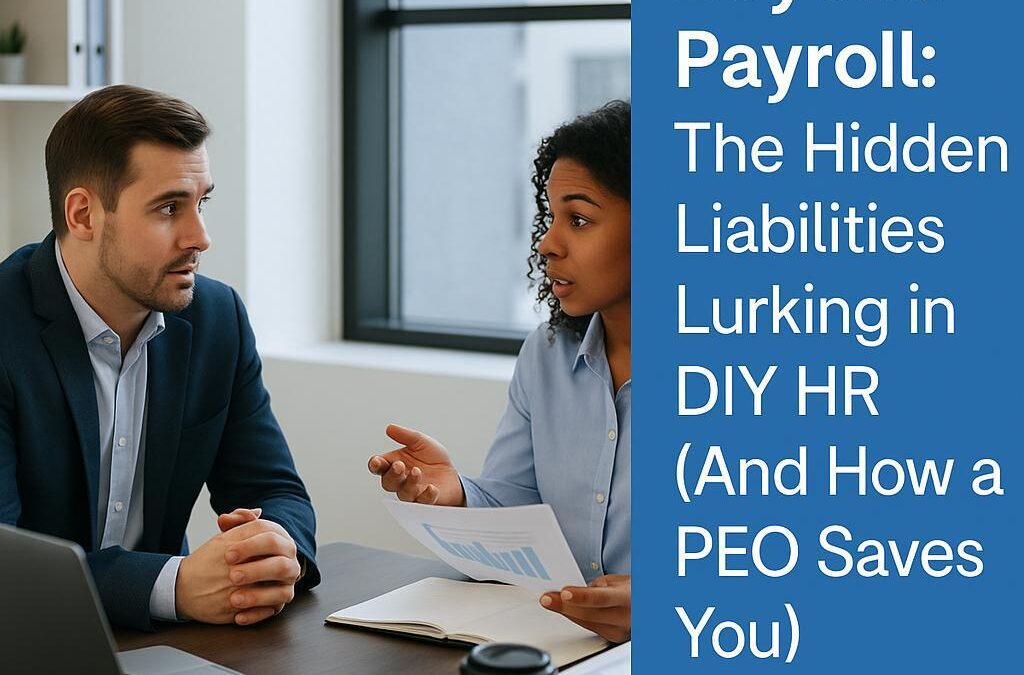You thought payroll software was the hard part? Think again. It started with a late-night call from the accountant. A former contractor had filed for unemployment but… contractors don’t get unemployment benefits, right? Wrong. That’s when the panic started. Turns out, your HR software may have misclassified a worker. Not on purpose—but software doesn’t catch gray areas. It calculates. It doesn’t caution. It processes—not protects. This is the challenge with DIY HR. For fast-scaling businesses, juggling payroll tools, spreadsheets, and guesswork, it’s a lawsuit waiting to happen. A PEO (Professional Employer Organization) does more than automate tasks—it shoulders risk, shares liability, and becomes your HR shield.
In this post, we’ll expose the hidden landmines buried under DIY HR practices and show how a PEO helps you avoid penalties, reduce risk, and stay compliant while you grow.
Employee Misclassification: A Hidden Tax Bomb
The IRS and Department of Labor take misclassification seriously. If you’re labeling someone a 1099 contractor when legally they’re a W-2 employee, you could be responsible for back taxes, overtime, benefits, and penalties.
Payroll software won’t stop you, it’ll let you misclassify with confidence.
A PEO helps you assess roles, responsibilities, and control factors to properly classify every worker. It also provides documentation and legal guidance if you’re audited.
FMLA, OSHA, and ADA Compliance: You’re Expected to Know
Most small businesses assume that if they’re under 50 employees, federal HR laws don’t apply. That’s not always true. State laws often kick in sooner, and certain industries like healthcare or construction, face additional compliance layers.
Your software won’t flag that. A PEO will. (HR software cannot flag a misclassification. A PEO is the fine-tooth comb that ensures any errors are caught)
PEOs provide guidance on:
- FMLA eligibility and leave tracking
- OSHA reporting and safety training
- ADA accommodation policies
- HIPAA and employee privacy
They don’t just give templates—they give advice that fits your state, your sector, and your risk profile.
Onboarding and Termination Errors = Lawsuit Triggers
Hiring and firing seem straightforward—until they’re not. Terminating an employee without the right documentation, or onboarding someone without signed policies, can open the door to lawsuits, unemployment claims, or discrimination complaints. Most payroll software doesn’t track:
- Progressive discipline
- Acknowledgment of policies
- Compliance training
- Exit interview documentation
A PEO keeps audit trials, generates compliant paperwork, and coaches your managers on how to avoid unlawful termination claims.
Handbooks and Policies That Aren’t Legally Binding
Google can’t write your employee handbook and even if it did, labor laws are constantly changing. There is no one-size-fits-all solution.
Many DIY HR handbooks:
- Use outdated legal terms
- Don’t include state-mandated policies (e.g., meal breaks, paid sick leave)
- Lack signed acknowledgments
- Are unenforceable in court
A PEO crafts a legally compliant handbook that’s reviewed annually. It ensures your team is trained on policies and that disciplinary procedures hold up if challenged.
Benefits Missteps: You Could Be Breaking the Law (Not Just Losing Talent)
Offering benefits without understanding your fiduciary obligations? You could be violating ERISA (Employee Retirement Income Security Act).
Common DIY HR mistakes:
- Offering retirement plans without proper documentation
- Mishandling open enrollment deadlines
- Failing to disclose plan changes
- Providing healthcare to contractors (invalidating classification)
PEOs administer benefits under their umbrella. This means:
- Better rates via group purchasing
- Accurate ACA reporting
- COBRA compliance
- Proper benefits election documentation
Wage and Hour Pitfalls: Your Software Won’t Alert You
Do you think your time-tracking system covers you? Think again. Most lawsuits in labor courts revolve around unpaid overtime, improper rounding, and rest break violations.
Payroll software may not:
- Flag improper tip pooling
- Handle minor labor laws for teenage workers
- Comply with California’s strict overtime calculations
- A PEO has HR professionals who audit your timesheets and coach your managers on compliant scheduling.
You’re Alone in a Crisis—Unless You Have a PEO
Whether it’s a data breach, an employee lawsuit, or a harassment allegation—crises happen. And software won’t jump on a call with you at 7 AM to guide your response. A PEO will.
They assist with:
- Crisis communications
- Internal investigations
- Legal counsel coordinatio
- Employee relations and sensitivity training
Think about it: Would you rather explain yourself in court… or prevent the lawsuit altogether?
Final Thought: DIY HR Is a Liability, not a Savings Plan
Payroll software is a tool. But it’s not a team.
When you rely on DIY HR solutions:
- You assume all the risk
- You lose compliance coverage
- You miss red flags
- When you work with a PEO:
- You reduce liability
- You gain proactive support
- You unlock expert guidance at every turn
- If your business is growing, your HR shouldn’t be guessing.
- A PEO doesn’t replace your payroll software—it replaces your anxiety.
References
- U.S. Department of Labor – https://www.dol.gov/newsroom/releases
- ExtensisHR https://extensishr.com/resource/blogs/why-small-businesses-need-peo/
- Zurich Insurance – https://www.zurichna.com/knowledge/articles/2022/10/top-causes-of-employment-lawsuits
- Business.com – https://www.business.com/articles/surprising-perks-peos/
- US Chamber – https://www.uschamber.com/co/run/human-resources/peos-vs-payroll-services
- Nolo – https://www.nolo.com/legal-encyclopedia/independent-contractor-vs-employee-29502.html
- IRS – https://www.irs.gov/businesses/small-businesses-self-employed/independent-contractor-self-employed-or-employee

